The wireless EEG monitoring system market is expected to grow from USD 0.9 billion in 2025 to USD 1.6 billion by 2035, supported by expanding clinical and research applications for continuous brain activity measurement. Market dynamics are being shaped by the rising prevalence of neurological conditions such as epilepsy, Alzheimer’s disease, Parkinson’s disease, and sleep-related disorders, which require long-duration monitoring for accurate diagnosis and treatment planning. Wireless EEG systems enable ambulatory and home-based recording, reducing dependence on hospital-based monitoring suites and improving patient comfort during extended data collection. This shift toward real-world, continuous monitoring is helping clinicians capture more accurate neurological event patterns than short-duration clinical recordings.
In the research domain, increasing investment in cognitive neuroscience, brain-computer interface development, and neuro-performance analytics is driving demand for lightweight, high-resolution, multi-channel wireless EEG platforms. Improved electrode materials, dry-contact sensor designs, and motion artifact reduction algorithms are enhancing data quality and expanding use in mobile environments, sports performance labs, and behavioral research centers. Integration with cloud-based analytics, AI-driven pattern recognition, and telemedicine platforms is becoming a key differentiator, enabling real-time remote interpretation and quicker diagnostic decision-making.
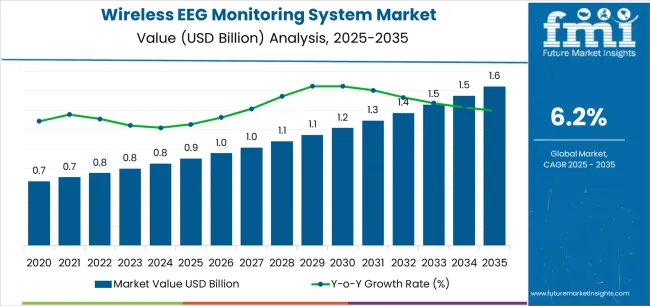
The latter half (2030-2035) will witness sustained growth from USD 1.2 billion to USD 1.6 billion, representing an addition of USD 400.4 million or 58% of the decade's expansion. This period will be defined by mass market penetration of specialized monitoring designs, integration with comprehensive telemedicine platforms, and seamless compatibility with existing hospital infrastructure. The market trajectory signals fundamental shifts in how healthcare providers approach neurological assessment optimization and brain activity analysis management, with participants positioned to benefit from sustained demand across multiple system types and end-use application segments.
The Wireless EEG Monitoring System market demonstrates distinct growth phases with varying market characteristics and competitive dynamics. Between 2025 and 2030, the market progresses through its technology adoption phase, expanding from USD 0.9 billion to USD 1.2 billion with steady annual increments averaging 6.2% growth. This period showcases the transition from basic wired monitoring to advanced head-mounted wireless systems with enhanced signal quality and integrated data transmission systems becoming mainstream features.
The 2025-2030 phase adds USD 338.8 million to market value, representing 42% of total decade expansion. Market maturation factors include standardization of neurological monitoring and brain research protocols, declining component costs for specialized wireless electrodes, and increasing industry awareness of ambulatory monitoring benefits reaching 95-98% signal accuracy in epilepsy and sleep study applications. Competitive landscape evolution during this period features established medical device manufacturers like Natus Medical and Compumedics expanding their wireless EEG portfolios while specialty manufacturers focus on advanced algorithm development and enhanced patient comfort capabilities.
From 2030 to 2035, market dynamics shift toward advanced integration capabilities and global healthcare expansion, with growth continuing from USD 1.2 billion to USD 1.6 billion, adding USD 400.4 million or 58% of total expansion. This phase transition centers on specialized wireless monitoring systems, integration with artificial intelligence networks, and deployment across diverse neurological and cognitive scenarios, becoming standard rather than specialized applications. The competitive environment matures with focus shifting from basic monitoring capability to comprehensive brain analysis optimization systems and integration with cloud-based diagnostic platforms.
| Metric | Value |
|---|---|
| Market Value (2025) | USD 0.9 billion |
| Market Forecast (2035) | USD 1.6 billion |
| Growth Rate | 6.2% CAGR |
| Leading Technology | Head-mounted Systems Type |
| Primary Application | Epilepsy Monitoring Application Segment |
The market demonstrates strong fundamentals with head-mounted wireless EEG systems capturing a dominant share through advanced portability design and patient mobility capabilities. Epilepsy monitoring applications drive primary demand, supported by increasing seizure disorder prevalence and continuous monitoring technology requirements. Geographic expansion remains concentrated in developed markets with established neurology infrastructure, while emerging economies show accelerating adoption rates driven by healthcare expansion and rising neurological awareness standards.
Market expansion rests on three fundamental shifts driving adoption across the neurology, sleep medicine, and cognitive research sectors. First, ambulatory monitoring demand creates compelling operational advantages through wireless EEG systems that provide continuous brain activity recording and patient mobility without compromising diagnostic accuracy, enabling clinicians to meet rigorous assessment standards while maintaining patient comfort and reducing hospitalization requirements. Second, neurological diagnostics modernization accelerates as hospitals worldwide seek advanced wireless systems that complement traditional monitoring methods, enabling precise seizure detection and sleep pattern analysis that align with clinical standards and diagnostic requirements.
Third, cognitive research enhancement drives adoption from neuroscience laboratories and rehabilitation centers requiring effective monitoring solutions that maximize data collection quality while maintaining operational flexibility during behavioral studies and brain-computer interface operations. However, growth faces headwinds from signal quality cost challenges that vary across wireless manufacturers regarding the reduction of electromagnetic interference and artifact contamination, which may limit adoption in electrically noisy environments. Technical limitations also persist regarding battery life concerns and electrode contact issues that may reduce effectiveness in extended-duration monitoring and physically active scenarios, which affect recording reliability and data requirements.
The wireless EEG monitoring system market represents a specialized yet critical diagnostic opportunity driven by expanding global neurological disorder burden, sleep medicine advancement, and the need for superior brain activity assessment in diverse clinical applications. As healthcare providers worldwide seek to achieve 95-98% signal accuracy, enable patient mobility, and integrate advanced wireless systems with diagnostic platforms, wireless EEG monitoring systems are evolving from basic recording devices to sophisticated analysis solutions ensuring clinical accuracy and diagnostic leadership.
The market's growth trajectory from USD 0.9 billion in 2025 to USD 1.6 billion by 2035 at a 6.2% CAGR reflects fundamental shifts in neurology practice requirements and ambulatory monitoring optimization. Geographic expansion opportunities are particularly pronounced in Asia Pacific markets, while the dominance of head-mounted systems and epilepsy monitoring applications provides clear strategic focus areas.
Strengthening the dominant head-mounted wireless EEG segment through enhanced electrode design, superior signal transmission, and patient-friendly configurations. This pathway focuses on optimizing wireless connectivity, improving wearing comfort, extending operational effectiveness to 95-98% accuracy rates, and developing specialized designs for diverse applications. Market leadership consolidation through advanced sensor engineering and miniaturization integration enables premium positioning while defending competitive advantages against traditional wired systems. Expected revenue pool: USD 48-65 million
Rapid neurology and sleep medicine growth across Asia Pacific creates substantial expansion opportunities through local production capabilities and clinical training partnerships. Growing neurological disorder prevalence and government healthcare initiatives drive sustained demand for advanced wireless monitoring systems. Localization strategies reduce equipment costs, enable faster clinical support, and position companies advantageously for hospital procurement programs while accessing growing domestic markets. Expected revenue pool: USD 42-58 million
Expansion within the dominant epilepsy monitoring segment (40.0% market share) through specialized wireless designs addressing seizure detection standards and long-term monitoring requirements. This pathway encompasses ambulatory seizure monitoring, medication adjustment support, and compatibility with diverse epilepsy management processes. Premium positioning reflects superior seizure detection and comprehensive diagnostic accuracy supporting modern epilepsy care. Expected revenue pool: USD 38-52 million
Strategic expansion into sleep research applications (30.0% market share) requires enhanced comfort capabilities and specialized wireless formulations addressing home-based monitoring operational requirements. This pathway addresses sleep disorder diagnosis, circadian rhythm assessment, and polysomnography alternatives with advanced signal processing for demanding sleep medicine standards. Premium pricing reflects specialized comfort requirements and extended recording standards. Expected revenue pool: USD 32-44 million
Development of specialized wireless EEG formulations for cognitive and emotional research (18.0% share) and neurorehabilitation (10.0%), addressing specific brain-computer interface requirements and therapeutic monitoring demands. This pathway encompasses attention assessment, meditation research, and stroke rehabilitation alternatives for emerging neuroscience applications. Technology differentiation through proprietary algorithms enables diversified revenue streams while reducing dependency on single application platforms. Expected revenue pool: USD 28-38 million
Expansion of implantable and portable wireless EEG segments through enhanced invasive monitoring, surgical epilepsy evaluation, and specialized applications requiring continuous intracranial recording characteristics. This pathway encompasses presurgical mapping, depth electrode monitoring, and ultra-portable alternatives for ambulatory clinical scenarios. Market development through advanced implant engineering enables differentiated positioning while accessing specialized markets requiring surgical-grade monitoring solutions. Expected revenue pool: USD 24-33 million
Development of superior signal processing algorithms addressing diagnostic accuracy and automated seizure detection across epilepsy and sleep applications. This pathway encompasses machine learning integration, real-time analysis capabilities, and comprehensive diagnostic automation. Premium positioning reflects technological leadership and algorithm expertise while enabling access to advanced diagnostic programs and AI-focused clinical partnerships. Expected revenue pool: USD 20-28 million
Primary Classification: The market segments by system type into Head-mounted Systems, Implantable Systems, Portable Systems, Multichannel Professional Systems, and Others categories, representing the evolution from stationary monitoring to mobile neurological assessment solutions for comprehensive brain activity optimization.
Secondary Classification: Application segmentation divides the market into Epilepsy Monitoring, Sleep Research, Cognitive and Emotional Research, Neurorehabilitation, and Others sectors, reflecting distinct requirements for recording duration, signal quality, and diagnostic precision standards.
Regional Classification: Geographic distribution covers Asia Pacific, Europe, North America, and other regions, with developed markets leading adoption while emerging economies show accelerating growth patterns driven by neurology expansion programs.
The segmentation structure reveals technology progression from conventional wired systems toward specialized wireless platforms with enhanced mobility and signal capabilities, while application diversity spans from clinical epilepsy monitoring to specialized cognitive research and rehabilitation applications requiring precise brain activity assessment solutions.
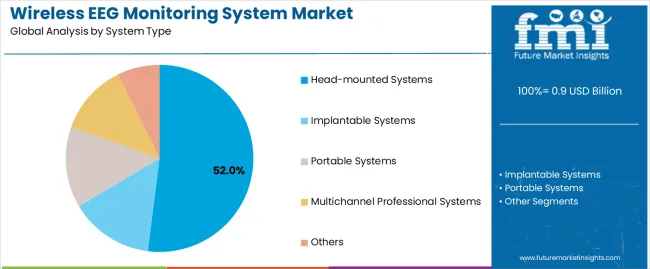
Market Position: Head-mounted wireless EEG systems command the leading position in the Wireless EEG Monitoring System market with approximately 52.0% market share through advanced portability properties, including superior patient mobility, lightweight construction, and recording optimization that enable clinicians to achieve optimal diagnostic accuracy across diverse ambulatory and clinical environments.
Value Drivers: The segment benefits from healthcare provider preference for mobile monitoring systems that provide consistent signal quality, reduced patient discomfort, and diagnostic reliability without requiring continuous hospitalization. Advanced design features enable natural patient movement, home-based monitoring, and integration with existing diagnostic software, where recording accuracy and patient compliance represent critical clinical requirements.
Competitive Advantages: Head-mounted wireless EEG systems differentiate through proven ambulatory capability, consistent signal transmission, and integration with cloud storage systems that enhance diagnostic effectiveness while maintaining optimal data quality suitable for diverse neurological applications.
Key market characteristics:
Portable wireless EEG systems maintain versatile monitoring positioning in the Wireless EEG Monitoring System market due to their compact design properties and multi-environment advantages. These systems appeal to facilities requiring flexible monitoring capabilities with adequate performance for bedside and ambulatory applications. Market adoption is driven by point-of-care expansion, emphasizing reliable diagnostic solutions and operational efficiency through optimized battery systems while maintaining competitive equipment costs.
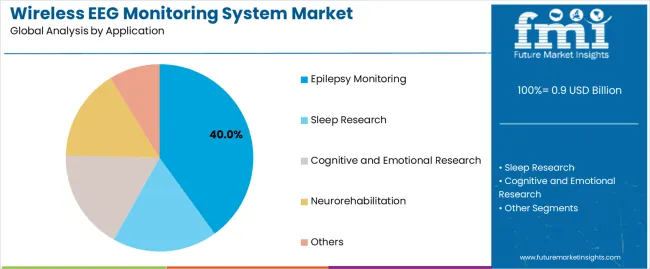
Market Context: Epilepsy monitoring applications dominate the Wireless EEG Monitoring System market with approximately 40.0% market share due to widespread adoption of ambulatory seizure monitoring and increasing focus on medication optimization, surgical evaluation, and long-term management applications that minimize hospital visits while maintaining diagnostic standards.
Appeal Factors: Neurologists prioritize recording reliability, seizure detection accuracy, and integration with existing epilepsy management infrastructure that enables coordinated monitoring across multiple patient populations. The segment benefits from substantial neurology department investment and epilepsy management programs that emphasize the acquisition of wireless systems for continuous monitoring and treatment optimization applications.
Growth Drivers: Epilepsy prevalence expansion programs incorporate wireless EEG monitoring systems as standard diagnostic tools for seizure disorder operations, while drug-resistant epilepsy growth increases demand for extended monitoring capabilities that comply with presurgical evaluation standards and minimize diagnostic delays.
Market Challenges: Varying epilepsy protocols and seizure presentation differences may limit monitoring standardization across different neurology practices or clinical scenarios.
Application dynamics include:
Sleep research applications capture approximately 30.0% market share through specialized monitoring requirements in sleep disorder diagnosis, insomnia evaluation, and home-based polysomnography applications. These facilities demand comfortable wireless systems capable of maintaining signal quality while providing overnight recording capability and sleep architecture analysis.
Cognitive and emotional research applications account for approximately 18.0% market share, neurorehabilitation captures 10.0%, while other segments represent 2.0%, including brain-computer interface development, meditation research, and specialized neuroscience applications requiring wireless EEG capabilities for brain activity assessment and experimental compliance.
Growth Accelerators: Neurological disorder expansion drives primary adoption as wireless EEG monitoring systems provide superior ambulatory recording capabilities that enable healthcare providers to meet diagnostic accuracy standards without prolonged hospitalization costs, supporting epilepsy management and sleep disorder missions that require continuous brain activity assessment applications. Patient mobility infrastructure demand accelerates market expansion as neurology clinics seek effective wireless systems that minimize patient discomfort while maintaining diagnostic effectiveness during extended monitoring and home-based recording scenarios. Healthcare technology spending increases worldwide, creating sustained demand for portable monitoring systems that complement traditional diagnostic processes and provide clinical efficiency in resource-constrained environments.
Growth Inhibitors: Signal quality cost challenges vary across wireless manufacturers regarding the elimination of electromagnetic interference and motion artifacts, which may limit operational reliability and market penetration in regions with electrical noise concerns or artifact-sensitive diagnostic operations. Technical performance limitations persist regarding battery life constraints and electrode adhesion issues that may reduce effectiveness in extended-duration monitoring, physically active scenarios, or multi-day recording conditions, affecting data completeness and diagnostic requirements. Market fragmentation across multiple recording standards and neurological protocols creates compatibility concerns between different wireless manufacturers and existing clinical infrastructure.
Market Evolution Patterns: Adoption accelerates in epilepsy and sleep medicine sectors where ambulatory monitoring justifies wireless equipment costs, with geographic concentration in developed markets transitioning toward mainstream adoption in emerging economies driven by neurology expansion and diagnostic awareness. Technology development focuses on enhanced signal algorithms, improved battery integration, and compatibility with artificial intelligence systems that optimize seizure detection and diagnostic effectiveness. The market could face disruption if dry electrode technologies or non-contact sensing innovations significantly limit the deployment of traditional wireless EEG systems in neurological applications, though wireless EEG's unique combination of diagnostic accuracy, patient mobility, and clinical validation continues to make it preferred in epilepsy applications.
The Wireless EEG Monitoring System market demonstrates varied regional dynamics with Growth Leaders including China (8.4% CAGR) and India (7.8% CAGR) driving expansion through neurology capacity additions and sleep medicine modernization programs. Steady Performers encompass Germany (7.1% CAGR), Brazil (6.5% CAGR), United States (5.9% CAGR), United Kingdom (5.3% CAGR), and Japan (4.7% CAGR), benefiting from established neurology industries and advanced wireless monitoring adoption.
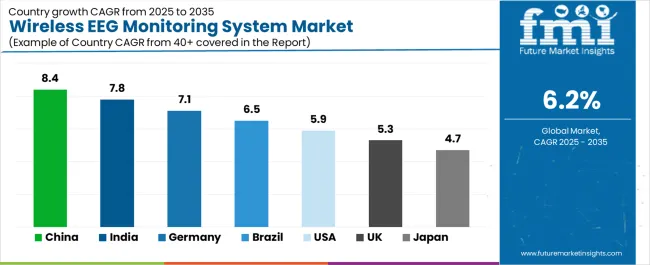
| Country | CAGR (2025-2035) |
|---|---|
| China | 8.4% |
| India | 7.8% |
| Germany | 7.1% |
| Brazil | 6.5% |
| United States | 5.9% |
| United Kingdom | 5.3% |
| Japan | 4.7% |
Regional synthesis reveals Asia Pacific markets leading adoption through neurology infrastructure expansion and sleep disorder awareness development, while European countries maintain steady expansion supported by ambulatory monitoring advancement and diagnostic standardization requirements. North American markets show moderate growth driven by epilepsy center applications and telemedicine integration trends.
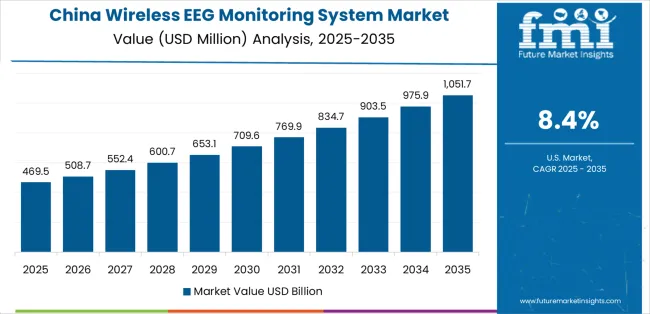
The Chinese market emphasizes advanced monitoring features, including precision signal processing and integration with comprehensive telemedicine platforms that manage diagnostic quality, seizure detection optimization, and remote monitoring applications through unified cloud systems. The country demonstrates strong growth at 8.4% CAGR, driven by neurology department expansion, sleep medicine initiatives, and emerging epilepsy center development that support wireless EEG integration. Chinese healthcare facilities prioritize operational effectiveness with wireless EEG monitoring systems delivering consistent diagnostic accuracy through advanced algorithm capabilities and patient mobility features.
Technology deployment channels include major hospital neurology departments, specialized medical device distributors, and healthcare procurement programs that support clinical applications for complex epilepsy monitoring and sleep disorder diagnosis applications. Platform integration capabilities with established hospital information systems expand market appeal across diverse operational requirements seeking diagnostic efficiency and telemedicine benefits. The expanding neurological disease burden and accelerating sleep disorder awareness create sustained demand, while innovative applications in brain-computer interfaces and cognitive assessment open new growth avenues.
Performance Metrics:
Germany's advanced neurology market demonstrates sophisticated wireless EEG deployment with documented clinical effectiveness in epilepsy monitoring applications and sleep medicine facilities through integration with existing diagnostic systems and clinical infrastructure. The country leverages engineering expertise in medical device manufacturing and signal processing integration to maintain strong growth at 7.1% CAGR. Industrial centers, including Frankfurt, Munich, and Hamburg, showcase premium installations where wireless EEG systems integrate with comprehensive hospital platforms and epilepsy management systems to optimize neurological diagnostics and monitoring effectiveness.
German medical device manufacturers prioritize signal quality and EU compliance in product development, creating demand for premium wireless systems with advanced features, including validated accuracy testing and automated artifact reduction. The market benefits from established neurology infrastructure and a willingness to invest in diagnostic technologies that provide long-term clinical benefits and compliance with international medical device and quality standards.
Market Intelligence Brief:
The USA wireless EEG monitoring system market demonstrates sophisticated deployment across epilepsy applications with documented effectiveness in ambulatory seizure monitoring and sleep disorder facilities through integration with comprehensive electronic health record systems and diagnostic infrastructure. The country leverages advanced technology capabilities in medical device innovation and algorithm development to maintain moderate growth at 5.9% CAGR. Industrial centers, including Boston, San Francisco, and Minneapolis, showcase premium installations where wireless EEG systems integrate with comprehensive epilepsy platforms and telemedicine networks to optimize diagnostic accuracy and monitoring effectiveness.
American healthcare providers prioritize diagnostic precision and patient mobility in monitoring equipment development, creating demand for innovative wireless systems with advanced features, including artificial intelligence integration and automated seizure detection. The market benefits from established epilepsy center infrastructure and willingness to invest in diagnostic technologies that provide long-term clinical benefits and compliance with FDA and clinical practice standards.
Market Intelligence Brief:
The UK wireless EEG monitoring system market demonstrates advanced remote monitoring deployment with documented clinical effectiveness in ambulatory epilepsy applications and home-based sleep studies through integration with existing National Health Service systems and telemedicine infrastructure. The country leverages healthcare expertise in remote patient monitoring and clinical systems integration to maintain steady growth at 5.3% CAGR. Industrial centers, including London, Manchester, and Birmingham, showcase premium installations where wireless EEG systems integrate with comprehensive telemedicine platforms and neurology management systems to optimize resource efficiency and monitoring effectiveness.
British healthcare providers prioritize cost-effectiveness and clinical validation in monitoring equipment development, creating demand for validated wireless systems with advanced features, including remote data transmission and clinician dashboard integration. The market benefits from established neurology infrastructure and commitment to invest in telemedicine technologies that provide long-term healthcare benefits and compliance with UK and EU medical device standards. Epilepsy monitoring applications, sleep disorder systems, and remote consultation programs drive diversified demand across multiple end-use segments.
Strategic Market Indicators:
India's wireless EEG monitoring system market demonstrates rapid expansion deployment with documented clinical effectiveness in hospital epilepsy applications and sleep disorder facilities through integration with emerging neurology systems and diagnostic infrastructure. The country leverages growing manufacturing capabilities in medical device production and clinical systems integration to achieve high growth at 7.8% CAGR. Industrial centers, including Mumbai, Delhi, and Bangalore, showcase expanding installations where wireless EEG systems integrate with comprehensive hospital platforms and diagnostic networks to optimize market penetration and clinical effectiveness.
Indian healthcare facilities prioritize cost efficiency and clinical validation in monitoring equipment development, creating demand for sophisticated wireless systems with advanced features, including automated analysis integration and affordability optimization. The market benefits from expanding neurology infrastructure and willingness to invest in international-standard diagnostic technologies that provide clinical accuracy and compliance with evolving healthcare standards.
Market Intelligence Brief:
Brazil's wireless EEG monitoring system market demonstrates growth deployment with documented clinical effectiveness in hospital epilepsy applications and sleep medicine facilities through integration with expanding neurology systems and healthcare infrastructure. The country leverages economic capabilities in healthcare growth and diagnostic systems integration to maintain steady growth at 6.5% CAGR. Industrial centers, including Sao Paulo, Rio de Janeiro, and Belo Horizonte, showcase expanding installations where wireless EEG systems integrate with comprehensive hospital platforms and neurology networks to optimize diagnostic capability and monitoring effectiveness.
Brazilian healthcare facilities prioritize clinical accuracy and accessibility in monitoring equipment development, creating demand for cost-effective wireless systems with advanced features, including tropical climate adaptation and reliable signal transmission. The market benefits from growing neurology infrastructure and commitment to invest in diagnostic technologies that provide clinical effectiveness and compliance with Brazilian healthcare standards.
Strategic Market Indicators:
Japan's wireless EEG monitoring system market demonstrates precision deployment with documented clinical effectiveness in premium epilepsy applications and specialized sleep medicine facilities through integration with advanced hospital systems and quality control infrastructure. The country leverages engineering excellence in medical device manufacturing and signal processing integration to maintain steady growth at 4.7% CAGR. Industrial centers, including Tokyo, Osaka, and Yokohama, showcase premium installations where wireless EEG systems integrate with comprehensive quality platforms and neurology management systems to optimize clinical excellence and diagnostic effectiveness.
Japanese healthcare facilities prioritize signal precision and clinical quality in monitoring equipment development, creating demand for ultra-premium wireless systems with advanced features, including micro-precision electrodes and quality integration systems. The market benefits from established neurology infrastructure and commitment to invest in highest-quality diagnostic technologies that provide superior clinical accuracy and compliance with stringent Japanese healthcare standards.
Strategic Market Indicators:
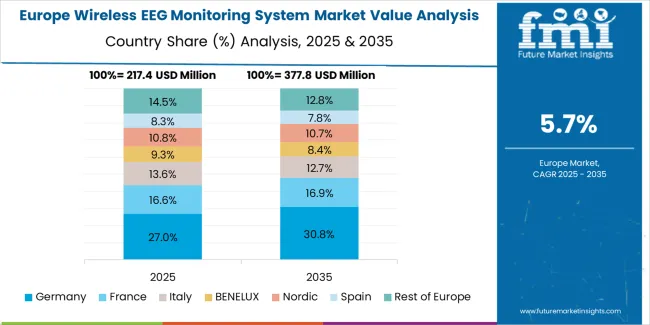
The Wireless EEG Monitoring System market in Europe is projected to grow from USD 245 million in 2025 to USD 410 million by 2035, registering a CAGR of 5.3% over the forecast period. Germany is expected to maintain its leadership position with a 32.8% market share in 2025, declining slightly to 31.9% by 2035, supported by its advanced neurology infrastructure and major epilepsy centers in Frankfurt and Munich. The United Kingdom follows with a 24.6% share in 2025, projected to reach 25.2% by 2035, driven by comprehensive telemedicine programs and remote monitoring initiatives.
France holds a 18.4% share in 2025, expected to increase to 19.0% by 2035 through steady neurology modernization activities. Italy commands a 11.2% share, while Spain accounts for 7.5% in 2025. The Rest of Europe region is anticipated to show steady adoption, expanding its collective share from 5.5% to 6.4% by 2035, reflecting consistent growth in Nordic countries, neurology expansion in Central European markets, and diagnostic technology upgrades across Eastern European healthcare facilities.

In Japan, the Wireless EEG Monitoring System market prioritizes head-mounted wireless EEG systems, which capture the dominant share of epilepsy center and hospital installations due to their advanced features, including precision portability optimization and seamless integration with existing neurology practice infrastructure.
Japanese healthcare facilities emphasize reliability, precision, and long-term diagnostic excellence, creating demand for head-mounted wireless systems that provide consistent monitoring capabilities and superior signal performance based on clinical requirements and quality standards. Multichannel professional systems maintain secondary positions primarily in research laboratory applications and surgical evaluation installations where comprehensive recording functionality meets operational requirements without compromising diagnostic efficiency.
Market Characteristics:

In South Korea, the market structure favors international medical device manufacturers, including Natus Medical Incorporated, Compumedics Limited, and Nihon Kohden Corporation, which maintain dominant positions through comprehensive product portfolios and established neurology networks supporting both epilepsy monitoring and sleep research installations.
These providers offer integrated solutions combining advanced wireless EEG systems with professional clinical training and ongoing technical support that appeal to Korean hospitals seeking reliable diagnostic equipment. Local medical device distributors and neurology consultants capture moderate market share by providing localized service capabilities and competitive pricing for standard clinical monitoring installations, while domestic manufacturers focus on specialized applications and cost-effective solutions tailored to Korean healthcare market characteristics.
Channel Insights:
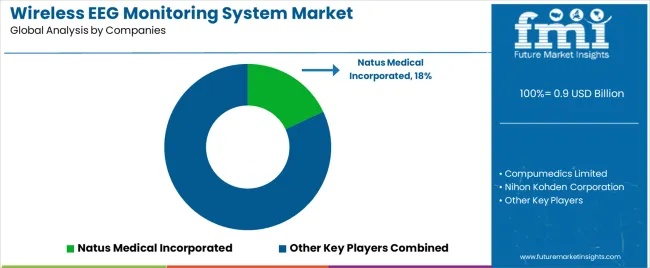
The Wireless EEG Monitoring System market operates with moderate concentration, featuring approximately 14-18 meaningful participants, where leading companies control roughly 44-50% of the global market share through established neurology relationships and comprehensive medical device portfolios. Competition emphasizes advanced signal processing capabilities, clinical validation, and regulatory compliance rather than price-based rivalry. The leading company, Natus Medical Incorporated, commands approximately 18.0% market share through its extensive neurological diagnostic product line and global epilepsy center presence.
Market Leaders encompass Natus Medical Incorporated, Compumedics Limited, and Nihon Kohden Corporation, which maintain competitive advantages through extensive neurology expertise, global hospital networks, and comprehensive wireless technology capabilities that create customer loyalty and support premium pricing. These companies leverage decades of EEG monitoring experience and ongoing innovation investments to develop advanced wireless systems with precision signal processing and diagnostic features. Technology Innovators include Neuroelectrics and regional specialists, which compete through specialized algorithm technology focus and innovative electrode capabilities that appeal to clinicians seeking advanced monitoring solutions and patient comfort enhancement.
These companies differentiate through rapid clinical validation cycles and specialized epilepsy application focus. Regional Specialists feature medical device manufacturers focusing on specific geographic markets and specialized applications, including implantable monitoring systems and integrated brain-computer interface solutions. Market dynamics favor participants that combine reliable signal acquisition with advanced wireless capabilities, including precision artifact reduction and automatic seizure detection features. Competitive pressure intensifies as traditional neurology equipment suppliers expand into wireless systems, while specialized neurotech companies challenge established players through innovative sensor solutions and cloud-based platforms targeting epilepsy monitoring and cognitive research segments.
| Item | Value |
|---|---|
| Quantitative Units | USD 0.9 billion |
| System Type | Head-mounted Systems, Implantable Systems, Portable Systems, Multichannel Professional Systems, Others |
| Application | Epilepsy Monitoring, Sleep Research, Cognitive and Emotional Research, Neurorehabilitation, Others |
| Regions Covered | Asia Pacific, Europe, North America, Latin America, Middle East & Africa |
| Countries Covered | China, India, Germany, Brazil, United States, United Kingdom, Japan, and 20+ additional countries |
| Key Companies Profiled | Natus Medical Incorporated, Compumedics Limited, Nihon Kohden Corporation, Neuroelectrics, g.tec medical engineering GmbH, Biosemi B.V., ANT Neuro, Mind Media B.V., Wearable Sensing, EMOTIV Inc., NeuroSky Inc., Cadwell Industries Inc., Medtronic plc, Masimo Corporation, Bitbrain Technologies |
| Additional Attributes | Dollar sales by system type and application categories, regional adoption trends across Asia Pacific, Europe, and North America, competitive landscape with medical device manufacturers and neurology equipment suppliers, clinician preferences for diagnostic accuracy and patient mobility, integration with telemedicine platforms and cloud monitoring systems, innovations in wireless electrode technologies and signal processing excellence, and development of artificial intelligence solutions with enhanced performance and diagnostic optimization capabilities. |
The global wireless EEG monitoring system market is estimated to be valued at USD 0.9 billion in 2025.
The market size for the wireless EEG monitoring system market is projected to reach USD 1.6 billion by 2035.
The wireless EEG monitoring system market is expected to grow at a 6.2% CAGR between 2025 and 2035.
The key product types in wireless EEG monitoring system market are head-mounted systems, implantable systems, portable systems, multichannel professional systems and others.
In terms of application, epilepsy monitoring segment to command 40.0% share in the wireless EEG monitoring system market in 2025.






Full Research Suite comprises of:
Market outlook & trends analysis
Interviews & case studies
Strategic recommendations
Vendor profiles & capabilities analysis
5-year forecasts
8 regions and 60+ country-level data splits
Market segment data splits
12 months of continuous data updates
DELIVERED AS:
PDF EXCEL ONLINE
Wireless Refrigerant Charging Scale Market Size and Share Forecast Outlook 2025 to 2035
Wireless Hydrometer Market Size and Share Forecast Outlook 2025 to 2035
Wireless HDMI Transmitter and Receiver Market Size and Share Forecast Outlook 2025 to 2035
Wireless Access Point Market Size and Share Forecast Outlook 2025 to 2035
Wireless Video - 2.4/5GHz Market Size and Share Forecast Outlook 2025 to 2035
Wireless Polysomnography Market Size and Share Forecast Outlook 2025 to 2035
Wireless Audio Devices Market Size and Share Forecast Outlook 2025 to 2035
Wireless Communication Technologies In Healthcare Market Size and Share Forecast Outlook 2025 to 2035
Wireless Mesh Network Market Size and Share Forecast Outlook 2025 to 2035
Wireless Sensor Tags Market Size and Share Forecast Outlook 2025 to 2035
Wireless Sensor Network Market Size and Share Forecast Outlook 2025 to 2035
Wireless Power Transmission Market Size and Share Forecast Outlook 2025 to 2035
Wireless Home Security Camera Market Size and Share Forecast Outlook 2025 to 2035
Wireless Testing Market Size and Share Forecast Outlook 2025 to 2035
Wireless Power Bank Market Size and Share Forecast Outlook 2025 to 2035
Wireless Printer Market Size and Share Forecast Outlook 2025 to 2035
Wireless Headphones Market Size and Share Forecast Outlook 2025 to 2035
Wireless Sensors Market Size and Share Forecast Outlook 2025 to 2035
Wireless Display Market Size and Share Forecast Outlook 2025 to 2035
Wireless Earphone Market Size and Share Forecast Outlook 2025 to 2035

Thank you!
You will receive an email from our Business Development Manager. Please be sure to check your SPAM/JUNK folder too.
Chat With
MaRIA